- The document presents proofs for representations of factorials as sums. Specifically, it proves that for any positive integer n, n! can be represented as the sum of terms involving binomial coefficients and powers of i from 0 to n.
- It shows this representation can be generalized by replacing the exponent i with i+k for any nonnegative integer k, based on properties of differences of polynomial sequences. This connects to earlier work by Euler.
- Further generalizations are given by replacing the exponent i with an arbitrary nonnegative integer l, relating the representation to Stirling numbers and combinatorics.
![arXiv:math/0702010v1[math.HO]1Feb2007
Factorials as sums
Roberto Anglani
Dipartimento Interateneo di Fisica “Michelangelo Merlin”, Universit`a degli Studi
di Bari,
Via Amendola 173, 70126 Bari, Italy
roberto.anglani@ba.infn.it
Margherita Barile1
Dipartimento di Matematica, Universit`a degli Studi di Bari, Via E. Orabona 4,
70125 Bari, Italy
barile@dm.uniba.it
Introduction
In this paper we give an additive representation of the factorial, which can
be proven by a simple quick analytical argument.
We also present some generalizations, which are linked, on the one hand to an
arithmetical theorem proven by Euler (decomposition of primes as the sum
of two squares), and, on the other hand, to modern combinatorics (Stirling
numbers).
1 From calculus to combinatorics
Proposition 1 For every positive integer n,
n! =
n
i=0
(−1)n−i n
i
in
.
Proof .For all x ∈ R we have the following first order Taylor expansion with
Lagrange remainder of the exponential function about 0:
ex
= 1 + x + x2
g(x),
1
Partially supported by the Italian Ministry of Education, University and Research.
1](https://image.slidesharecdn.com/d3329a0b-3225-4e87-93a0-5fbf35103ee2-150702092431-lva1-app6892/75/Factorials-as-sums-1-2048.jpg)
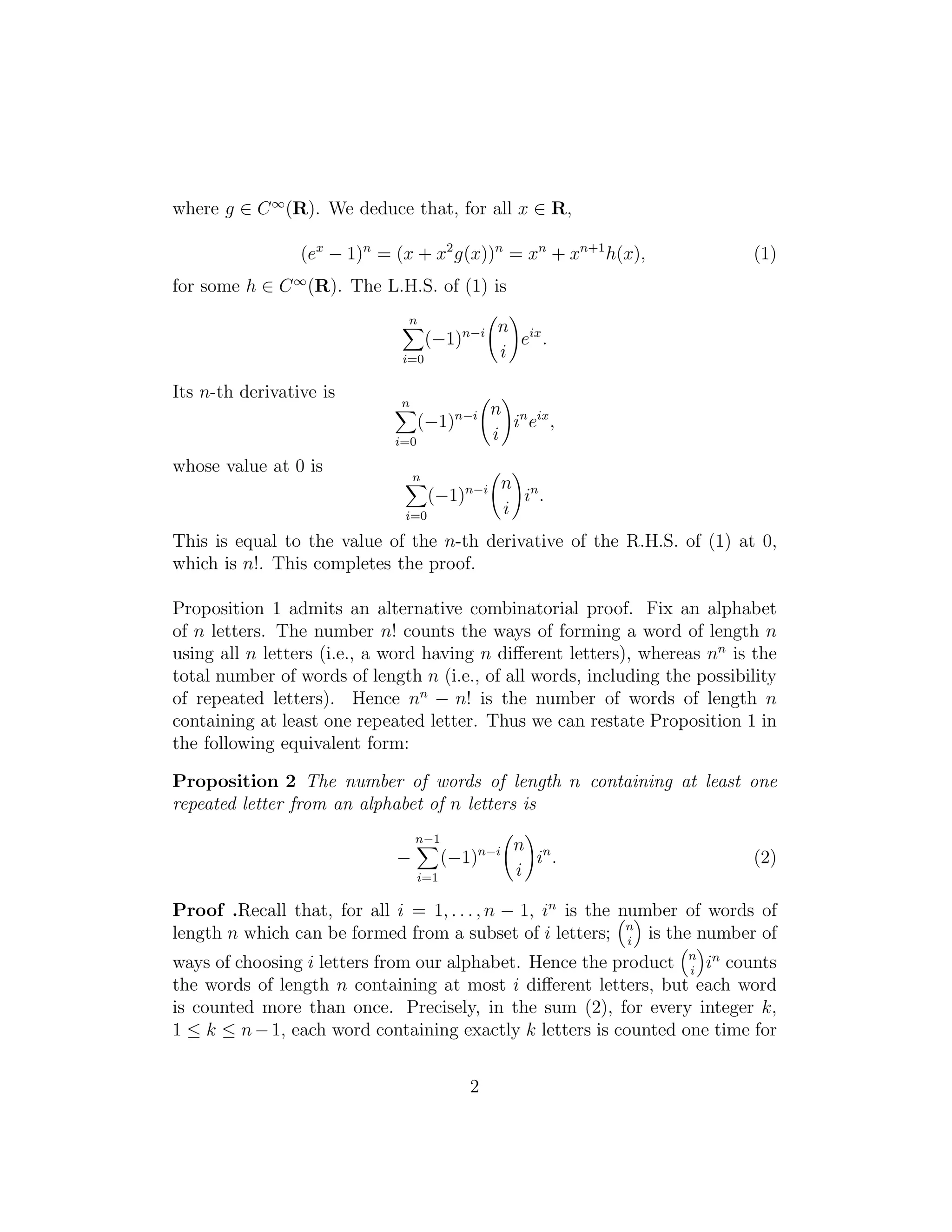
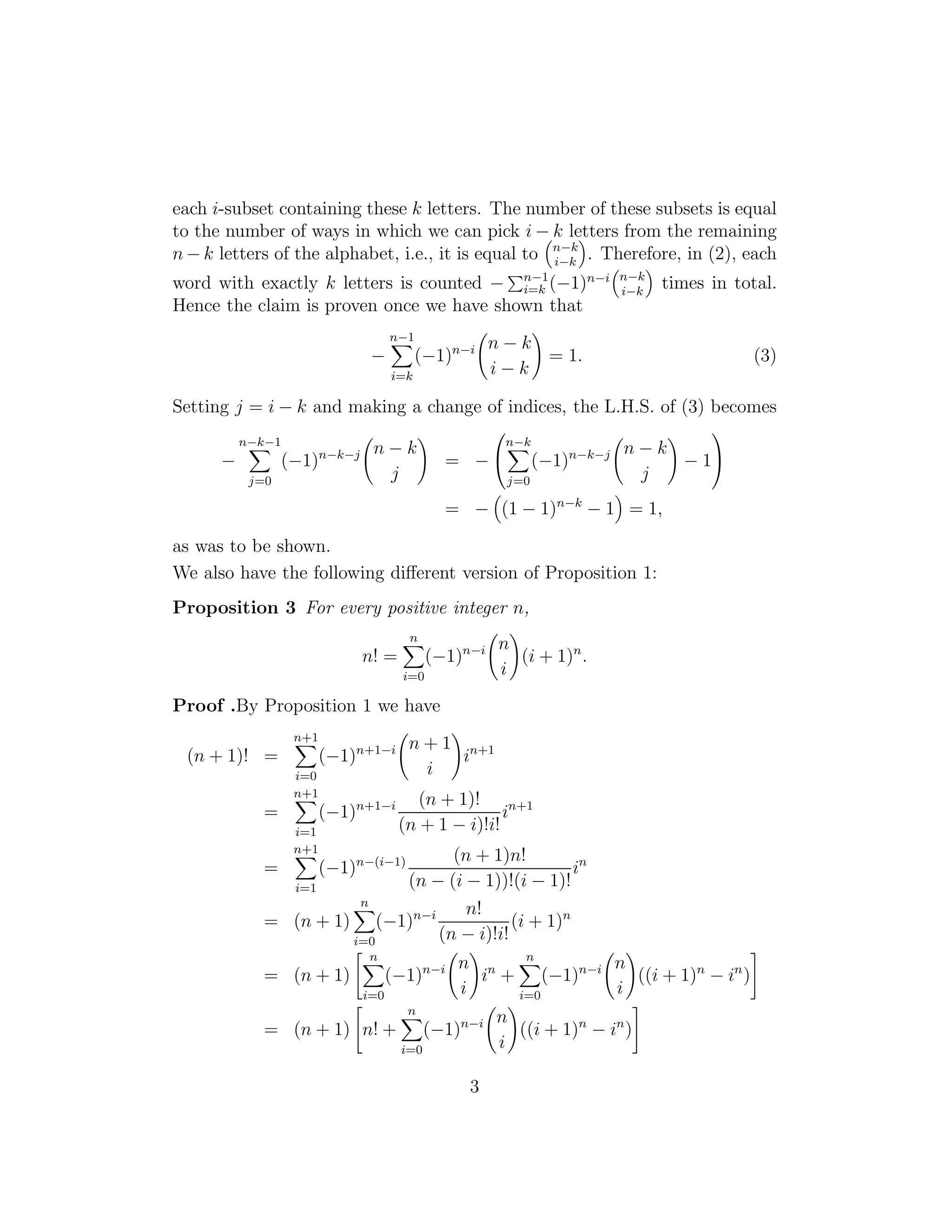
![By comparing the first and the last expression in the above sequence of
equalities, it follows that
n
i=0
(−1)n−i n
i
((i + 1)n
− in
) = 0.
In view of Proposition 1 this proves the claim.
2 Euler’s approach
In the preceding section, Proposition 3 was obtained from Proposition 1 by
replacing in
with (i + 1)n
. We are going to show that, more generally, for
every positive integer n, the identity
n! =
n
i=0
(−1)n−i n
i
(i + k)n
(4)
holds for all nonnegative integers k. This will be a consequence of Proposition
6 below. Identity (4) was proven by Euler [3] in a purely arithmetical context.
In this section we essentially follow his line of thoughts.
Definition 1 Given a sequence (ak)k≥0 of real numbers, its first difference
is defined as the sequence whose k-th term is
∆1
ak = ak+1 − ak.
Recursively, for every integer n > 1, the n-th difference is defined as the first
difference of (∆n−1
ak)k≥0.
Proposition 4 For every positive integer n and all nonnegative integers k,
∆n
ak =
n
i=0
(−1)n−i n
i
ak+i.
Proof .Let k be a nonnegative integer. We prove the claim for k by induction
on n. The claim is obviously true for n = 1. Now let n ≥ 2 and suppose the
claim true for n − 1. We prove it for n and k. We have
∆n
ak = ∆n−1
ak+1 − ∆n−1
ak
4](https://image.slidesharecdn.com/d3329a0b-3225-4e87-93a0-5fbf35103ee2-150702092431-lva1-app6892/75/Factorials-as-sums-4-2048.jpg)
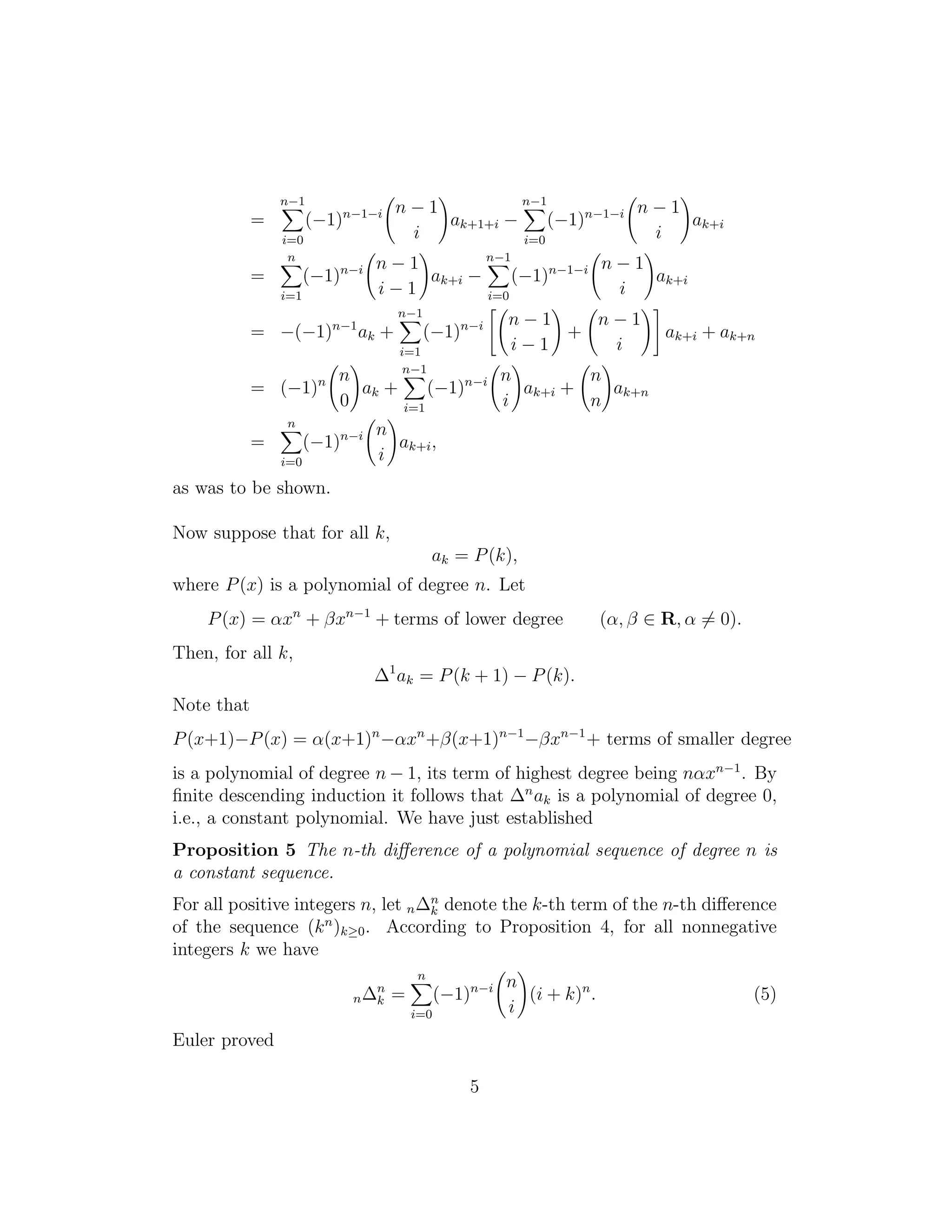
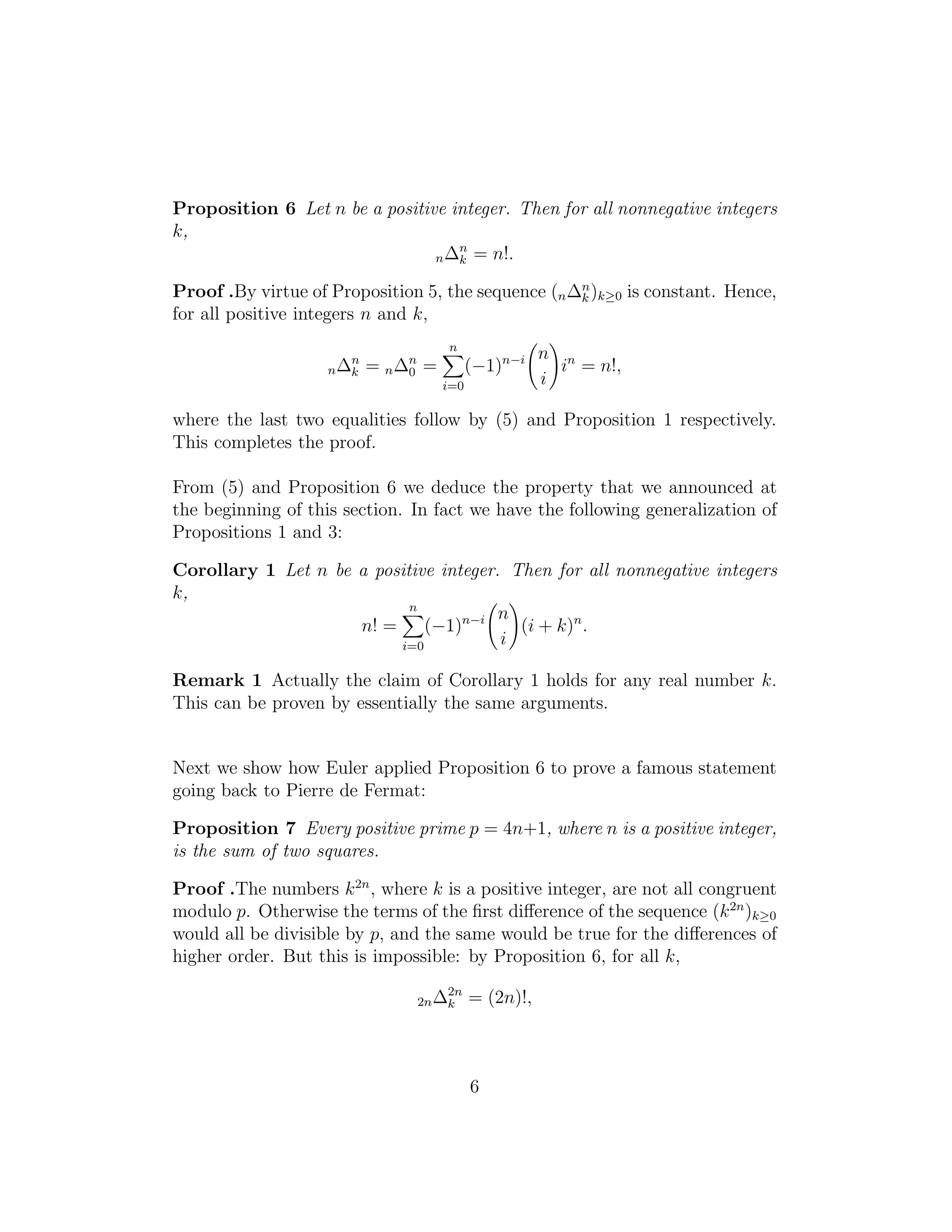
![and p = 4n + 1 does not divide any of the factors of (2n)!, since these are all
smaller than p. Hence there are two positive integers k and h such that
p does not divide h2n
− k2n
. (6)
Evidently we may assume that 1 ≤ h < k < p. Then p does not divide h and
k. Consequently, by Fermat’s Little Theorem, hp−1
≡ kp−1
(mod p), so that
p divides hp−1
− kp−1
= h4n
− k4n
= (h2n
+ k2n
)(h2n
− k2n
).
Therefore, taking (6) into account,
p divides h2n
+ k2n
.
According to a former result by Euler (see Propositio 4 in [2]), if a number is
the sum of two squares, then the same is true for all its prime divisors that
do not divide the two squares. Hence p is the sum of two squares.
3 Stirling numbers
Corollary 1 is an arithmetical generalization of Proposition 1. We now give
another generalization that is relevant from a combinatorial point of view: it
consists in replacing the exponent n with an arbitrary nonnegative integer ℓ.
Following the arguments used in the proof of Proposition 1, we can conclude
that
n
i=0
(−1)n−i n
i
iℓ
is equal to the ℓ-th derivative of (ex
− 1)n
at 0. This is equal to ℓ! times the
coefficient C(ℓ, n) of xℓ
in the Taylor series expansion of (ex
−1)n
at 0. Since
ex
− 1 =
ℓ
i=1
xi
i!
+ xℓ+1
g(x)
for some g ∈ C∞
(R), we can compute C(ℓ, n) as the coefficient of xℓ
in the
following polynomial:
ℓ
i=1
xi
i!
n
. (7)
7](https://image.slidesharecdn.com/d3329a0b-3225-4e87-93a0-5fbf35103ee2-150702092431-lva1-app6892/75/Factorials-as-sums-7-2048.jpg)
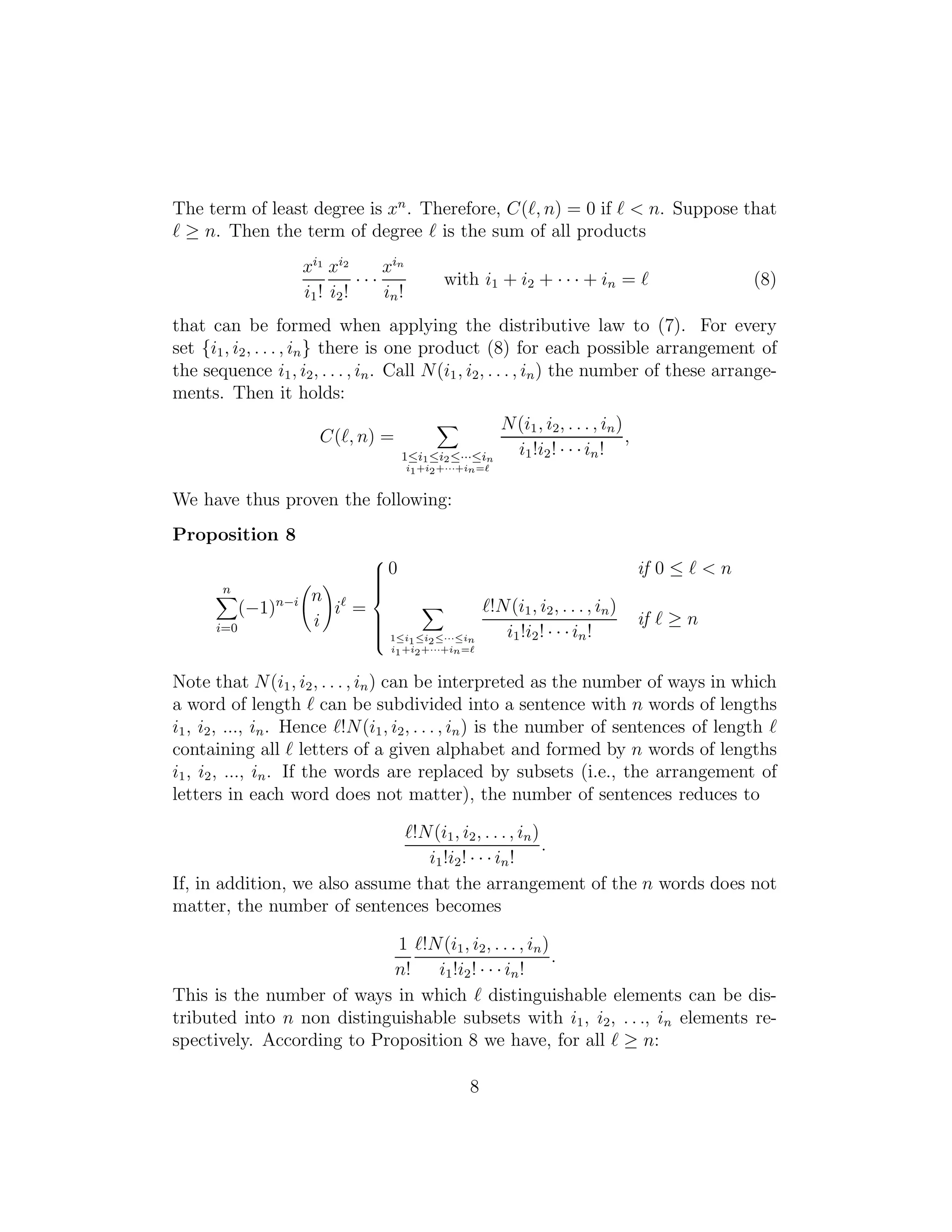
![n
i=0
(−1)n−i 1
(n − i)!i!
iℓ
=
1≤i1≤i2≤···≤in
i1+i2+···+in=ℓ
1
n!
ℓ!N(i1, i2, . . . , in)
i1!i2! · · · in!
,
and this number is equal to the total number of ways in which ℓ elements can
be distributed into n non empty subsets. It is well-known in combinatorics.
Definition 2 The numbers
S(ℓ, n) =
n
i=0
(−1)n−i 1
(n − i)!i!
iℓ
(0 < n ≤ ℓ)
are called Stirling numbers (of the second kind).
More details on Stirling numbers can be found in [4], Chapter 3, or in [1].
Remark 2 If in the formula of Definition 2 we replace iℓ
with (i+ 1)ℓ
, then,
as one can easily check, we obtain another Stirling number:
S(ℓ + 1, n + 1) =
n
i=0
(−1)n−i 1
(n − i)!i!
(i + 1)ℓ
.
4 Negative exponents
We finally present some identities which extend those of the preceding sec-
tions when the exponent is ℓ = −1. The proofs that are based on easy
induction arguments will be omitted. The first result is related to Proposi-
tion 8.
Proposition 9 For all positive integers n
n
i=1
(−1)n−i n
i
1
i
= (−1)n−1
n
i=1
1
i
.
The term on the R.H.S. of the claim is, up to the sign, the sum of the first
n terms of the well-known harmonic series.
Next we replace
1
i
with
1
i + k
. We shall obtain, as in Proposition 1 and in
Corollary 1, an expression involving factorials.
9](https://image.slidesharecdn.com/d3329a0b-3225-4e87-93a0-5fbf35103ee2-150702092431-lva1-app6892/75/Factorials-as-sums-9-2048.jpg)

![References
[1] M. Eisen, Elementary Combinatorial Analysis, Gordon and Breach,
New York, London, 1969.
[2] L. Euler, De numeris qui sunt aggregata duorum quadratorum, Novi
commentarii academiae Petropolitanae 4 (1752/53), pp.3-40, also in:
Opera mathematica, pp.295-309.
[3] L. Euler, Demonstratio theorematis Fermatiani omnem numerum pri-
mum formae 4n+1 esse summam duorum quadratorum, Novi commen-
tarii academiae scientiarum Petropolitanae 5 (1754/55), pp.3-13. also
in: Opera mathematica, pp.328-337.
[4] J.H. van Lint, R.M. Wilson, A Course in Combinatorics, Cambridge
University Press, Cambridge, 1992.
11](https://image.slidesharecdn.com/d3329a0b-3225-4e87-93a0-5fbf35103ee2-150702092431-lva1-app6892/75/Factorials-as-sums-11-2048.jpg)